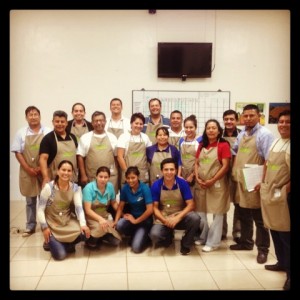Our Central American Regional Let’s Talk Coffee® event functioned as an opportunity to carry out the Cuppers Guild meeting. Cuppers from our Central American supply chain, México, Guatemala, Nicaragua, Honduras and El Salvador were present at the cupping sessions, where we sought to calibrate SCAA format by submitting samples of different qualities and attributes, observing the coffee profiles and microlots from different countries, and evaluating samples from various present organizations and comparing them to samples with Roya.
With the attendance of 12 cuppers, we evaluated 19 coffees from 8 countries, adding up to a total of 95 cups of coffee tasted. We tasted natural coffee, honey process coffee, and coffee attacked by Roya in order to identify the main characteristics of these coffees.
Among the features present in Roya-attacked coffees were vegetable, legume, peas, peanuts, cerealose, and woody notes. The coffee profiles in terms of SCAA ratings displayed note differences 1 to 2 points below normal levels, as they became flat and neutral coffees.
According to statistics on samples from past harvests, neutral notes were repeated in 43% of the samples tested this year and the peanut notes that were not present in the previous harvests now dominate at 38%. Additionally, astringent notes appear more frequently.
 Performing calibration sessions and characterizing and identifying profiles, like Roya, allows us to deliver the best tools for cuppers to assess quality levels and, above all, establish integrated management plans with technicians, with the support of management, in order to prevent the fading of cup profile characteristics in each area.
Performing calibration sessions and characterizing and identifying profiles, like Roya, allows us to deliver the best tools for cuppers to assess quality levels and, above all, establish integrated management plans with technicians, with the support of management, in order to prevent the fading of cup profile characteristics in each area.
This, accompanied by talks with experts, is definitely key when offering support to producers in the time when they need information, knowledge, and tools, like the Roy Toolkit. Undoubtedly, this has had a positive impact on producers and organizations in that it has enabled them to find practical and effective solutions for their crops.



.png)
